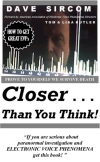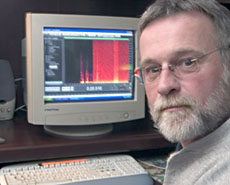RECORDING EVPs -- FREQUENCY RESPONSE RATE & SAMPLE RATE
by Dave Sircom, guest contributor [June 26, 2009]
[WeeklyUniverse.com] Most, if not all, of the technology used in ghosthunting today was originally intended for an altogether different purpose. Video cameras with infrared capabilities weren't invented with ghosthunters in mind, nor thermal cameras such as those manufactured by FLIR -- but thank Heavens we've got them. Likewise for digital audio recorders, electromagnetic field detectors, and all of today's audio editing software.
My best Class "A" and "B" EVPs were captured with low-end digital and analog recorders. Over the years, I've collected thirteen different recorders, from Radio Shack to Sony.
I'm a huge Sony fan. Whenever possible, I buy Sony. The problem I've had with Sony digital recorders was not hardware, but software that would download the audio to my computer. I found the software difficult to use, and slow.
That said, one of my favorite recorders is the Panasonic DR60. This recorder was pulled from the market by the manufacturer, because consumers were complaining of the voices being recorded on messages when no one else was present! The DR60 is a great recorder, if you can find one -- but you need to able to distinguish a real EVP from digital static.
Of all the recorders I've used, and seen others use, Olympus ranks #1. Recently, I bought an Olympus WS-210S. It's been worth every penny. It can be pulled in half and has a built-in USB plug, no cord needed. It records in stereo, has a great frequency response range, and the software downloads the audio in better than acceptable speed, using software already on your Windows system.
I'm often asked, why did one recorder pick up an EVP, but the other recorder, located in the same room, did not? There can be several answers. The most probable explanation is that it "didn't hear it." This is because of the "frequency response" or the range of the recorder's ability to hear sound.
My Olympus WS-210S has a frequency response rate begining at 150 Hz at the low end, and a high end range up to 17,000 Hz in stereo XQ mode. This high end can be adjusted, depending on the recording mode selected. Always check your recording mode, so you know your recording frequency range.
Here's the range for the WS-210S:Stereo XQ Mode: 150-17,000 HzStereo SP Mode: 150-9,000 HzStereo HQ Mode: 150-15,000 HzHQ Mode: 150-13,000 HzSP Mode: 150-7,000 Hz
LP Mode: 150-3,000 Hz
I also use an analog SONY M-529V microcassette recorder with an external microphone to keep out the internal "gear noise." But the frequency range is from 300 Hz to 4000 Hz. This means it cannot hear anything above 4000 Hz or below 300 Hz.
My next favorite analog recorder is the Radio Shack CTR-121 Desktop Cassette Recorder. The frequency response is 125 Hz to 6300 Hz, and uses high bias tapes.EVPs can come from anywhere, but my experience has been that I get the best results from the 150 Hz to 4000 Hz range. But I don't want to miss a thing!Another important consideration is the "Sample Rate" or as Wikipedia puts it:
"The sampling rate, sample rate, or sampling frequency defines the number of samples per second (or per other unit) taken from a continuous signal to make a discrete signal. For time-domain signals, it can be measured in hertz (Hz). The inverse of the sampling frequency is the sampling period or sampling interval, which is the time between samples. The concept of sampling frequency can only be applied to samplers in which samples are taken periodically. Some samplers may sample at a non-periodic rate. The common notation for sampling frequency is fs which stands for frequency (subscript) sampled."
My next favorite analog recorder is the Radio Shack CTR-121 Desktop Cassette Recorder. The frequency response is 125 Hz to 6300 Hz, and uses high bias tapes.EVPs can come from anywhere, but my experience has been that I get the best results from the 150 Hz to 4000 Hz range. But I don't want to miss a thing!Another important consideration is the "Sample Rate" or as Wikipedia puts it:
"The sampling rate, sample rate, or sampling frequency defines the number of samples per second (or per other unit) taken from a continuous signal to make a discrete signal. For time-domain signals, it can be measured in hertz (Hz). The inverse of the sampling frequency is the sampling period or sampling interval, which is the time between samples. The concept of sampling frequency can only be applied to samplers in which samples are taken periodically. Some samplers may sample at a non-periodic rate. The common notation for sampling frequency is fs which stands for frequency (subscript) sampled."
Simply stated, the more often (or the higher the sample rate), the more authentic or true to the original sound is the recording. Human speach usually ranges from 50 Hz to somewhere around 4000 Hz, but can go higher. This is why telephones are desinged to go up to 8000Hz.
It's generally accepted that 20,000 Hz is the maximum frequency that the human ear can detect. A dog, however, has a hearing of about 50 Hz to 45,000 Hz. So, in order to detect these human frequencies, your sample rate must be, at least, double that amount.
If you're trying to capture EVPs at 4000Hz, you must have a minimum sample rate of over 8000 Hz. I usually set a sample rate of 44,000Hz because I like a wide frequency response rate of 150 Hz to 17,000 Hz -- and I don't want to miss a thing!
 |
Dave Sircom is the author of Closer Than You Think, an expert's study on Electronic Voice Phenomenon.His email: CTYT@comcast.net.
|
 |

|
